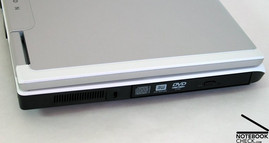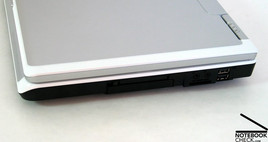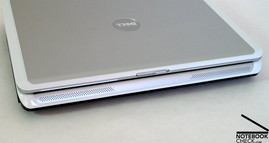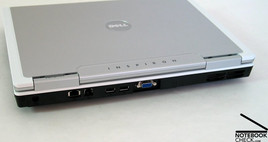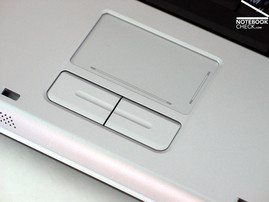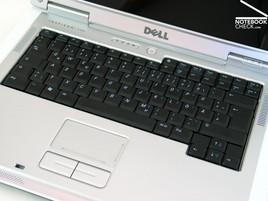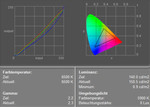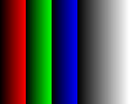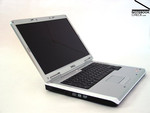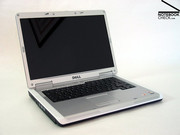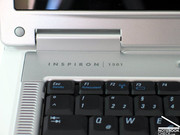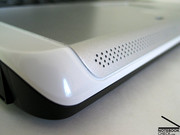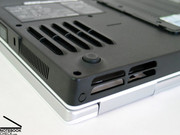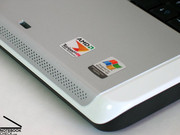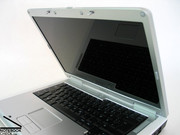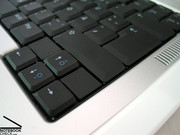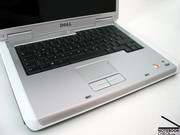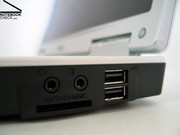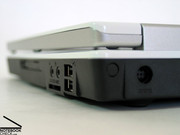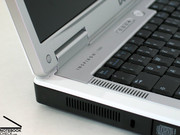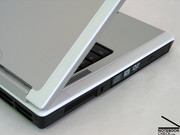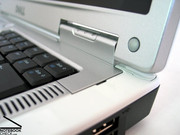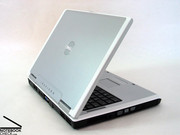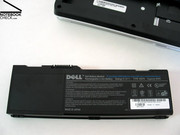Review Dell Inspiron 1501 Notebook
Case
Slowly but steadily were are finally able to cover a part of Dell's notebook series. After our reviews of the Dell XPS M1710, XPS M1210, Inspiron 9400 and Inspiron 6400, we review the Dell Inspiron 1501, which is a very reasonable beginner's notebook.
The design indicates clearly that it is a notebook of the Inspiron series. It has a silver case with a black trough, which is surrounded by a white clear varnished molding.
The notebook looks sober, maybe even worthy, but not unattractive. The rounded edges and the cone-shaped front side, suggest at least some effort in design.
The case is exclusively made out of plastics. Still, the notebook is robust and we could nearly observe any deformations or creaking noises during the pressure test. Even the display is comparably flexural rigid.
The big display hinges do not only look stable, they also allow it a maximum mobility of 180°. In practice the display is hold securely in every possible position. However, we could observe a slight see-saw.
The display comes with a ramshorn hook, which on the one hand holds the display securely in hinged position. On the other hand it allows heavy wobbling even in hinged position. In order to avoid a transport damage, the notebook has plastic nipples, which clearly protrude.
Most ports are - as usually for a Dell notebook- placed at the backside of the notebook and additionally at the back regions of the left and the right side of the notebook.
The Inspiron 1501's front side is free of ports. Also on the left side it has only the DVD drive, an Kensington lock and the fan holes.
At the backside there are a VGA-out for connecting an external display, a modem and a LAN port, the power connector and 2 USB 2.0 ports. At the right side there are two further USB 2.0 ports, a connector for a headset and a microphone, a 3in1 Cardreader and an ExpressCard slot.
At a closer look, one can see that Dell somewhat skimped on ports. E.g a firewire port or a S-Video out are missing. Furthermore, an optical sound out (S/PDIF) would be sometimes useful. However, the 4 USB 2.0 have to be rated positively as well as the order of the ports.
Input Devices
Because of missing additional keys, the operation area looks clear and ordered. Even the keyboard is designed reasonable and user-friendly.
All keys are of good size and can be reached easily. However, the edge of the case next to the keyboard might disturb a little bit when pressing the space bar.
Typing feels smooth, but there is a somewhat unclear action point. At the end the stroke is stopped ungentely. Therefore vigorous key strokes leads to considerable noise emissions.
Similarly to other Dell notebooks, one can't complain about the touch pad. The response and the control are without any anomalies. Its surfaces allows smooth sliding.
Once again both touch pad buttons are worthy of remark. They can be characterized by user-friendly dimensions and a comfortable travel, which makes them easy to use.
Display
Dell's Inspiron 1501 is equipped with a 15.4 inch display with a resolution of 1280x800 pixels, which is offered either with matt surface or as "TrueLife" variant with reflecting surface. We reviewed the "TrueLife" variant. According to Dell, the advantage of the "TrueLife" version is an essentially better contrast ratio compared to the version with matt surface. However, under bad lightening conditions the "TrueLife" display reflects.
The diagram of the display measurement uncovers slightly lowered color curves. The blue curve deviates slightly more. This leads to the usual slight dominance of red colors.
| |||||||||||||||||||||||||
Brightness Distribution: 85 %
Contrast: 167:1 (Black: 0.9 cd/m²)
We measure a good maximum brightness of 154.3 cd/m² at a good illumination of 84.8%. The minimum measured brightness was 0.9 cd/m², which leads together with the maximum brightness to an acceptable maximum contrast ratio of 171:1. The notebook reached grade 6 in the Pixperan test of legibility, which is an average result.
The display of the Dell Inspiron 1501 has an acceptable range of operation. When looking from bottom to top, the picture gets quickly darker and gets nearly completely dark at very acute angles. When looking from top to bottom, the display gets brighter, but not that extreme. Horizontally, the possible vantage points from left and right are absolutely sufficient. At too acute angles one can observe reflections and pale colors.
Performance
If one looks around, one could easily come to the conclusion that all recent notebooks come with Intel processors. Dell Inspiron's 1501 proves this wrong.
The Dell Inspiron 1501 is equipped with an AMD Turion 64 X2 CPU, which is AMD's counterpart to the Intel Core 2 Duo processor. Furthermore the notebook is equipped with an ATI Radeon 1150 Xpress video card with up to 256 MB memory.
The PCMark2004 as well as the PCMark2005 were aborted. The CPU test of the Super Pi program uncovered that the computing power of the Turion X2 CPU is clearly worse than the computing power of a Core Duo and even more clearly worse than the one of a Core 2 Duo CPU.
The benchmark results of the ATI Radeon 1150 Xpress video is comparable to the results of an Intel Graphics Media Accelerator (GMA) 950. All hopes to play the current demanding games well are therefore in vain. However, this CPU/GPU combination should be sufficient for Internet and Office applications.
Further information about the video card can be found here or in our comparison of mobile video cards. Detailed information about the Turion X2 CPU can be found here.
Please also look at our benchmark list of mobile processors or at our benchmark list of mobile video cards, in order to compare this notebook to other configurations.
| 3DMark 2001SE Standard | 2189 points | |
| 3DMark 03 Standard | 592 points | |
| 3DMark 05 Standard | 416 points | |
| 3DMark 06 Score Unknown Setting | 150 points | |
Help | ||
Emissions
Loudness
We were pleased that the Dell Inspiron 1501 was rather quite in idle mode and during use of office and Internet applications. Either the fans were completely deactivated of they ran at lowest level without disturbing.
Under load the notebook reached a maximum loudness of 38.7 db, whereby the revolutions of the fan change in a kind of sinus curve, which leads to a pulsing noise.
Noise level
| Idle |
| 30.9 / 37.2 / 33.8 dB(A) |
| HDD |
| 30.9 dB(A) |
| DVD |
| 35.8 / dB(A) |
| Load |
| 0 / 38.7 dB(A) |
 | ||
30 dB silent 40 dB(A) audible 50 dB(A) loud |
||
min: | ||
Temperature
The top side of the notebook is, besides a hot spot in the right back corner (37.2°C), without any noticeable anomalies. On the contrary, one can measure a clear temperature increase at the bottom side. Still, the maximum surface temperature of 43.7°C is acceptable.
Upper side
palmwrist: 26.3°C max: 37.3°C avg: 30.9°C
Bottom side
max: 43.7°C avg: 36.8°C
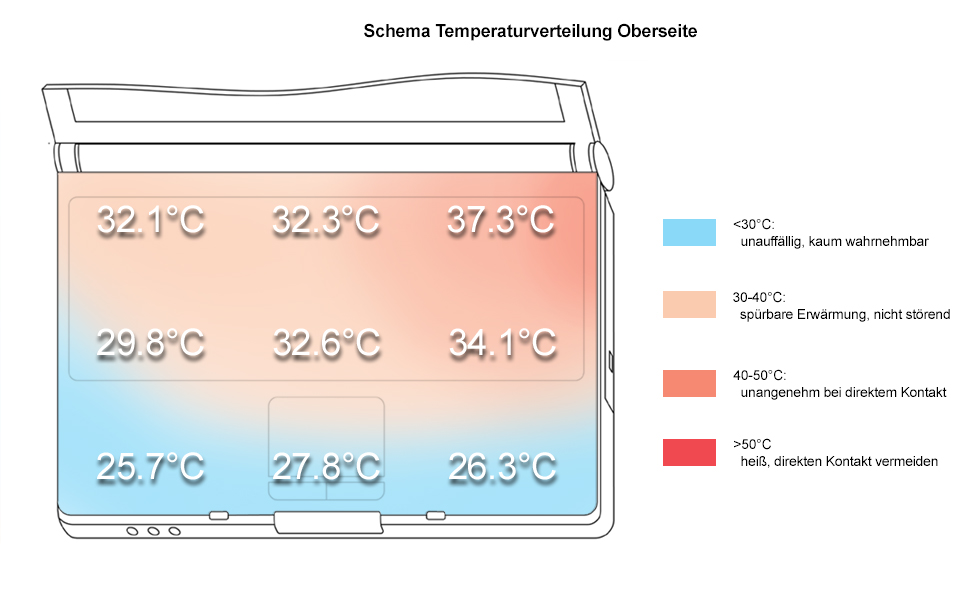
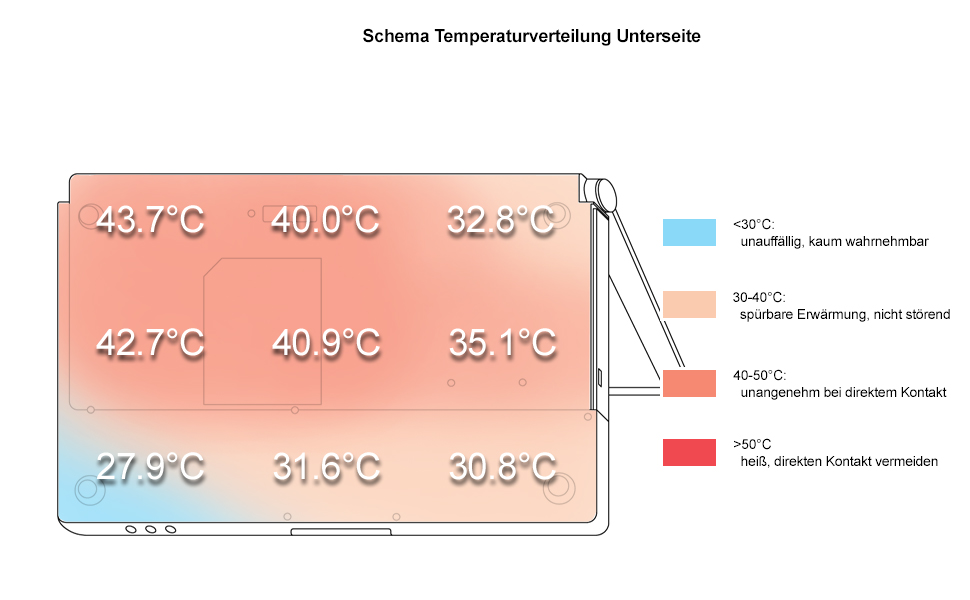
Speakers
The speakers, which are placed right and left at the front edge, have a nice sound. The basses are a little bit faded, but the total volume is respectable.
Battery Runtime
The reviewed notebook was equipped with an 85 Wh (7600 mAh) 9 cells Lithium-Ions battery, which is available for an additional charge of 23.- Euro. The investment is worth it, because this battery provides a 50% longer runtime.
In optimal power save mode without load the Inspiron has a runtime of over 6 hours!! Even under load it reached a minimum runtime of more than 2 hours. During playback of DVDs, configured at "minimum energy demand", but with maximum brightness, the runtime was remarkable above 4 hours. In total these is a very good result. Even with the standard 56 Wh battery one should have a good runtime (about minus 33%).
Energy Demand
Without load (Idle), min. brightness, without WLAN: 14.4 Watt
+ max. brightness: 19.5 Watt
+ WLAN: 20.1 Watt
full load (+WLAN, max brightness): max. 49.9 Watt
Verdict
Dell's Inspiron 1501 convinced through its excellent price / value ratio. One gets the proven robust Dell quality and an acceptable performance.
However, one must compromise on the equipment. E.g. a firewire port and digital sound and video outs are missing. Even bluetooth and infrared are not available.
Nevertheless, the Inspiron comes with everything, which is needed for a - to some extent - useful office notebook:
The input devices are alright, even if the keyboard seems a little bit coarse. The display is sufficient bright and well illuminated - the vantage point sufficient. The performance is alright and the emissions are especially regarding the noise very good. Last but not least, the Inspiron 1501 convinced through its excellent battery runtime.





